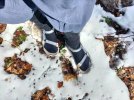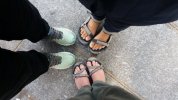- Time of past OR future Camino
- Sept/Oct 2023
OK-so I chose my shoes- they are comfy and supportiver. BUT, as trail runners, they don't protect at all from water. If I walk thru grass that is wet with dew they are soaked for my whole training walk. And I'm thinking that my feet might get cold if they are wet in late October, not to mention the risk for developing blisters. The wet shoe issue concerns me. Should it?
Seems like any nylon runner - type shoe will get wet. and stay wet. How have you dealt with this problem?
Seems like any nylon runner - type shoe will get wet. and stay wet. How have you dealt with this problem?
























